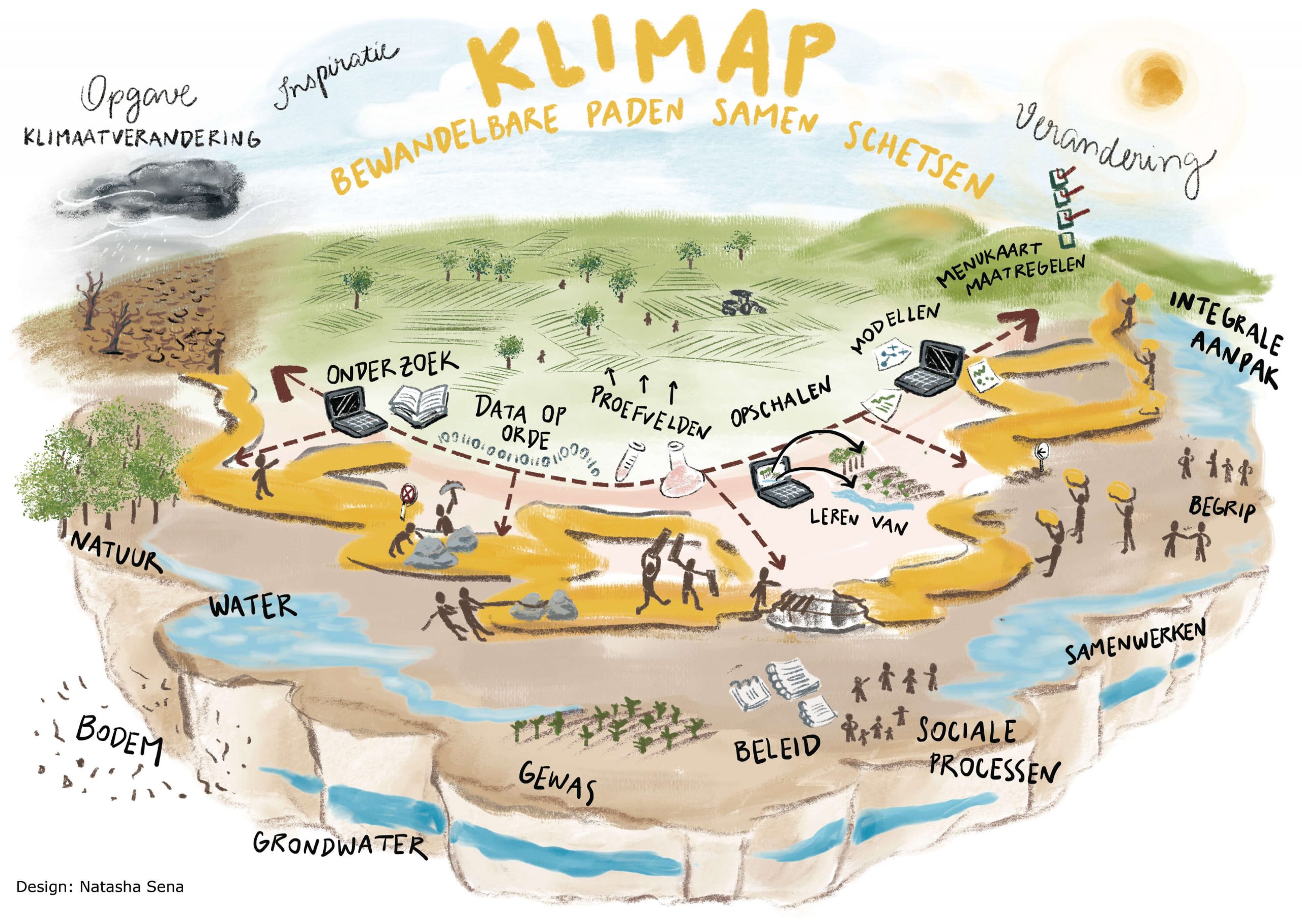Climate adaptation in practice (KLIMAP)
In the four-year KLIMAP project, a consortium of 24 organisations is looking at which measures can contribute, and what joint process will be needed, to adapt Dutch sandy areas to climate change. KLIMAP will be working through to the end of 2023 on process descriptions and instruments that will help the government authorities and actors in the region to implement the ‘development pathways’ approach. This is a method that makes it possible to take joint steps towards a climate-adaptive environment in constantly changing conditions. We are also developing a menu in KLIMAP that provides a clear overview of the effects and feasibility of various types of measures. KLIMAP is co-financed by the Agri & Food and Water & Maritime top sectors.

KLIMAP poster.
Technology
Climate change is leading to changes in the soil and water system in sandy areas of the Netherlands. Agriculture and nature are affected. The increasing differences between extreme drought and peak downpours with flooding make the enormous challenge that this involves abundantly clear. It has emerged that areas are not adequately structured to cope with the effects of climate change. This is seen, for example, in damage to crops as a result of drought, the increasing drying out of natural areas and localised problems with excess water on agricultural land during peak downpours.
A roadmap provides a structure for the process as a whole and connects the different KLIMAP products. The roadmap distinguishes between seven steps that partners in the region must take together. As they progress further, the partners will test and refine the products in various project areas, including the Northern IJssel Valley (in the province of Gelderland) and around the Mariapeel and Groote Molenbeek (in the province of Limburg). Gaps in the knowledge about the effectiveness of promising measures (technological and otherwise) will be addressed in field experiments in ‘Living Labs’.
Challenge
An overarching project activity will involve the design of Development Pathways, which are needed for the transition to the climate-resilient structuring and management of the soil-water system. These Development Pathways draw on process knowledge about the effectiveness of measures from the Testing Grounds and Living Labs work package, in combination with information from the Future Studies work package.
Development Pathways are an ongoing process for adapting quickly and flexibly (in gradual ways) to the effects of climate change in collaboration with the actors in the area processes. Rather than a route description from A (non-climate-proof) to B (climate-proof), a Development Pathway is a method that supports decision-making ‘on the hoof’. In this way, the resilience and adaptive capacity of actors and systems are strengthened structurally, which helps to achieve the longer-term objectives.
Testing Grounds and Living Labs serve as development and demonstration environments on different scales. Research is being conducted into the effectiveness of measures. New business models and the action perspectives for the actors in the area are explored. In Living Labs, we collect data that help to understand the measures so they can be extrapolated to effects and feasibility in testing grounds and elsewhere. The resulting data, process knowledge and understanding of the effect of measures serve as input for models and Future Studies and for shaping the steps in the Development Pathways.
Future studies can be, for example, scenario studies or policy studies. Using local information from the Testing Grounds and Living Labs, extrapolations are made in regional modelling studies to the effects on a larger scale. These instruments can be used to explore the consequences of climate and land-use scenarios and the effects of plans. This project is therefore preparing the instruments so that they can be used in catchment areas to evaluate the suitability and effectiveness of measures on a regional scale in collaboration with stakeholders.
In order to embed climate adaptation in regional processes, we are looking for links to environmental visions and establishing a connection with other current social issues such as biodiversity, the energy transition and the circular economy.
Solutions
KLIMAP provides the following solutions that contribute to climate adaptation in Dutch sandy areas:
- Tools for the transition based on Development Pathways (process approach) and instruments for the coordinated assessment of different factors.
- Answers to knowledge questions such as the effects of the intended measures on water authorities and all stakeholders in an area, and on various forms of land use, including new business models (circular and otherwise).
- Understanding of the spatial, economic and ecological consequences of measures.
- The practical suitability of instruments (such as models, assessment frameworks, process approaches for learning environments).